The River Tyne
Tuesday, 28th March 2006 by Alex Turnbull
Today we're going on a little tour of bridges over the River Tyne, which flows between Newcastle Upon Tyne and Gateshead, England. Seriously, stick with me, there's some really cool ones to see 😀
Starting at the edge of the high-res images to the west of Newcastle, the first bridge we encounter is the Newburn Bridge (1893) which only allows traffic to travel over it one way at a time.
Next up (when these pictures were taken) is the Blaydon Bridge (1990) which carries the "longest named road in Britain" - the A1, over the Tyne on its way between Edinburgh and London – a trip of 409 miles (658 km).
Just after that is the Scotswood Rail Bridge (1871), which was decommissioned in 1982, and now only carries water and gas mains.
Still in use however is the Scotswood Road Bridge (1967), a quietly impressive tied arch suspension bridge with a nice shadow.
Next, the Third Redheugh Bridge (1983) – thus named as two previous incarnations of this crossing have been replaced over the years. In fact you can still see the Southern Abutment of the second bridge.
Another rail bridge now, the King Edward VII Rail Bridge (1906). This bridge was built to allow trains to leave Newcastle Central station in either direction, by forming a giant loop over the river.
The strange-looking white bridge we encounter now is the Queen Elizabeth II Metro Bridge (1981) which was built to carry the Tyne and Wear metro system (a contender for Britain's oldest commuter railway among other firsts).
Now we come to the High Level Bridge (1849), a combination road and railway bridge. You can't see any cars on it because they run along a lower level - directly underneath the railway.
Immediately after that we find one of the largest swing bridges in the world* (see updates at end of post). Completed in 1876 the bridge's swinging section measures 86 metres (281 feet) in length and weighs 1200 tons - which can apparently be turned through 180 degrees in just 3 minutes (not bad for something 130 years old I thought).
Continuing east we find a bridge which may look vaguely familiar... this is the Tyne Bridge (1928), which is quite clearly based on the design of the previously posted Sydney Harbour Bridge ** (see updates at end of post).
Which brings us (eventually!) to the final, most recent, most expensive and most striking bridge over the Tyne. The Gateshead Millennium Bridge (2001) is a foot and cycle bridge which has huge hydraulic rams on either side, which tilt the bridge back on special pivots to allow small ships and boats to pass underneath - earning it the nickname of the 'Blinking Eye' bridge.
If you've never seen it in person then there's loads of images around of the bridge in action. Lots of people have however, as it's become a serious tourist attraction – and for 22 million quid I should certainly think so too!
If you've still not had enough of the River Tyne, make sure you follow it all the way out to sea, taking in the giant cranes, various half-built ships, a movable test gas rig, lots of ship-shaped holes and a pair of twin lighthouses along the way.
*Update: Scott Ventura says:
the El Ferdan Railway Bridge across the Suez Canal is the longest swing bridge, with a swing span of more than 300 meters
**Update 2: cookie monster says:
the mythology is that Sydney was the inspiration for the Tyne design and conceived first. The Tyne was finished first and Sydney just took longer to get built.
Thanks to Lindsay Marshall, Astec123 and everyone else who submitted any of these. Also big thanks to cycle-routes.org for making this trip for real (scroll down for the full cycle-level tour).
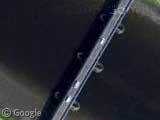
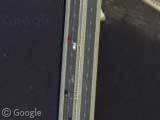

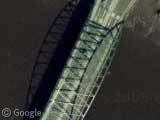

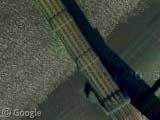
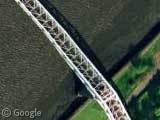

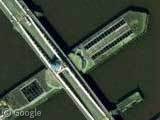
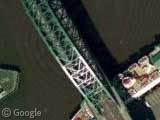
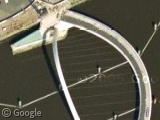

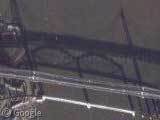

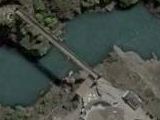
Is this a flea market? (swap meet).
View Placemark
I note that you say the Tyne bridge design is based on the Sydney Harbour Bridge. This surely should be the other way around The Tyne bridge is 4 years older. Please also note that the builder of the Sydney bridge was a Middleborough UK company.
You can see the entrances to the road tunnel, which is further downstream, here: View Placemark View Placemark Interestingly, both ends face south due to a loop in the tunnel north of the river.
The buildings containing lifts and escalators to the pedestrian/cycle tunnel can be seen here: View Placemark View Placemark
And for completeness, the South Shields ferry landing stage, complete with an approaching ferry: View Placemark
And the North Shields landing: View Placemark
The Wikipedia says the El Ferdan Railway Bridge across the Suez Canal is the longest swing bridge, with a swing span of more than 300 meters. I haven’t been able to spot it yet, but I’ve looked.
William – just a good old traditional market (South Shields Market to be exact) stpaddy – the mythology is that Sydney was the inspiration for the Tyne design and conceived first. The Tyne was finished first and Sydney just took longer to get built.
Could this be the El Ferdan Railway Bridge? Look at the shape of what appears to be an indentation on the western bank: View Placemark
Compare: http://www.unister.de/Unister/uploads/wissen/30000/30335_bild5_w2.gif
The cable-stayed road bridge is much easier to find: View Placemark
I went to this amazing pub last week: View Placemark
It’s called the Central and is like the shape of a mini FlatIron Building. There was a dog with a makeshift insulation tape bandage around its foot.
It’s in Gateshead, just before you hit the Tyne Bridge.
Ground level here: http://www.monkchester.co.uk/gateshead_18.htm
There’s a pretty amazing new concert hall in Gateshead too near that blinking eye bridge. It’s just a building site on the google maps though.
Ah – ive been in that boozer too BM of M. There was a match on but there was just me and this old boy in there (i presume the rest of the population were actually at the game) and they just had the radio on no telly or sky or whatever. I’m usually quite good with accents but i could not understand a word this old boy was saying (he was completely leathered though). Proper old skool pub!
The High Level Bridge is currently closed to road traffic for extensive refurbishment works…I think at one stage there was speculation that it might never reopen, but I believe the signs around the place imply that it will reopen next year…
We were playing a gig and someone recommended it.
we’d forgot the name of the pub and asked a punter.
what came out of his mouth was totally not ‘The Central’ – sounded more like the Severn but we were on the Tyne.
very confusing.
Not sure what it’s the centre of either?
I suspect its a railway thing! Newcastle’s station is called Central Station and that line just to the rear of the pub heads straight in to …..you’ve guessed it….Central Station. Railway Passage to the rear aswell!
Those Ship-shaped holes are so… pseudophallic…
excellent ground level shot of the swing bridge on flickr
Re: ST PADDY
The Tyne and Sydney Harbour bridge were both designed and constructed by Teesside based company (sadly no more) Dorman and Long. (Stockton) The main factory entrance is still preserved on the TEESDALE development site and shows the true scale of the opertaion.
They were a principal steel maker in the golden industrial age of the North east and supplied steel to numerous bridges around the world. The tyne bridge was actually concieved as a proving ground for the longer (nearly twice as) and more ambitious sydney harbour bridge, due to the similar geological and geographic conciderations. There are some fantastic pictures of its construction on google images.
Cool, my reference was made for this, Nice! Couldnt help it I live south of the place. Love this site and come over to take a look often. I must admit this site is quite an education. Quite unique learning of geography this way. Anyway just thought it cool I got a mention.
A